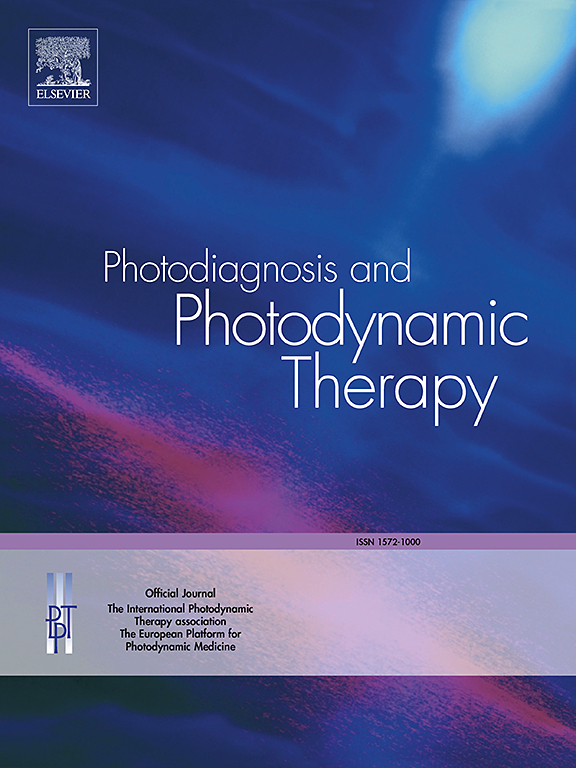Effect of ketorolac tromethamine on pain management in patients with condyloma acuminata treated with 5-aminolevulinic acid photodynamic therapy
IF 3.1
3区 医学
Q2 ONCOLOGY
引用次数: 0
Abstract
Background
Photodynamic therapy is widely used to treat condyloma acuminatum, which has the advantages of proven efficacy, low recurrence rates, and local minimally or non-invasive. However, patients often experience significant pain during the treatment. How to alleviate the pain experienced by patients during photodynamic therapy has become a key focus of current discussions.
Objective
To investigate the pain control and its safety and feasibility of ketorolac tromethamine combined with two-step irradiation in 5-aminolevulinic acid photodynamic therapy (ALA-PDT) for the treatment of condyloma acuminatum (CA).
Methods
A total of 92 patients were randomly assigned into the following three groups in this study. The first group, the combination group, received ketorolac tromethamine combined with the two-step irradiation (irradiation at 65 mW/cm² for 5 min, followed by 80 mW/cm² for 16 min; total energy: 96 J/cm²). The second group, the ketorolac group, received ketorolac tromethamine with irradiation at 80 mW/cm² for 20 min (96 J/cm²). The third group, the control group, used cold air analgesia with irradiation at 80 mW/cm² for 20 min (96 J/cm²). Pain scores during irradiation were recorded for all patients, using Visual Analogue Scale (VAS). Additionally, a questionnaire was taken to assess treatment satisfaction, pain improvement within 24 h, and any adverse reactions after therapy.
Results
During ALA-PDT, the median pain scores at 1 min and 5 min in the combination group were lower than those in the ketorolac group and the control group (median pain scores at 1 min: 2.0, 4.0, and 4.5, respectively; at 5 min: 5.0, 6.0, and 7.0, respectively). At 10 min and at the end of the treatment, the median pain scores in the combination group and the ketorolac group were lower than those in the control group (median pain scores at 10 min: 6.0, 6.0, and 7.0, respectively; at the end of treatment: 3.0, 4.0, and 5.0, respectively). All three groups reached peak pain levels between 5 and 10 min. After irradiation, the majority of patients in the combination group and the ketorolac group experienced mild pain (VAS scores of 1–3), with most reporting pain relief within 24 h. In contrast, the majority of patients in the control group experienced significant pain (VAS scores of 4–7), with pain lasting >24 h in most cases, showing a statistically significant difference (χ2 = 70.925, P < 0.001). In terms of adverse reactions, all three groups experienced pain, with some patients also exhibiting redness and swelling, erosion, itching, scabbing, and other symptoms. And there were no statistically significant differences in adverse reactions among the three groups (P>0.05). Regarding treatment satisfaction, the vast majority of patients in the combination group reported being very satisfied (87.1 %), with no patients expressing dissatisfaction. However, in the control group, 5 patients expressed dissatisfaction, and only 16 patients (53.3 %) reported being very satisfied. The ketorolac group had a satisfaction level that fell between the other two groups. The differences among the three groups were statistically significant (χ2 = 10.351, P = 0.025).
Conclusions
The application of ketorolac tromethamine can effectively relieve the pain of CA patients during ALA-PDT, especially in the later stages of treatment. Combining ketorolac tromethamine with the two-step irradiation method can further reduce pain generated in the initial stage of ALA-PDT and improve patient satisfaction with the treatment.
酮咯酸丙二胺对5-氨基乙酰丙酸光动力治疗尖锐湿疣患者疼痛控制的影响。
背景:光动力疗法被广泛应用于尖锐湿疣的治疗,具有疗效确切、复发率低、局部微创或无创性等优点。然而,患者在治疗过程中经常会经历明显的疼痛。如何减轻患者在光动力治疗过程中的疼痛已成为当前讨论的重点。目的:探讨酮乐酸三聚氰胺联合两步照射治疗尖锐湿疣(CA)的疼痛控制及安全性和可行性。方法:将92例患者随机分为以下3组。第一组为联合组,给予酮咯酸三聚氰胺联合两步照射(65 mW/cm²照射5分钟,随后80 mW/cm²照射16分钟;总能量:96 J/cm²)。第二组,酮咯酸组,接受酮咯酸三聚氰胺80 mW/cm²照射20分钟(96 J/cm²)。第三组为对照组,采用80mw /cm²辐照20分钟(96 J/cm²)的冷风镇痛。采用视觉模拟评分法(Visual Analogue Scale, VAS)记录照射过程中所有患者的疼痛评分。此外,采用问卷调查评估治疗满意度、24小时内疼痛改善情况以及治疗后的不良反应。结果:ALA-PDT时,联合用药组1分钟、5分钟疼痛中位评分低于酮罗拉酸组和对照组(1分钟疼痛中位评分分别为2.0、4.0、4.5;在5分钟:5.0,6.0和7.0分别)。在治疗10分钟和结束时,联合组和酮罗拉酸组的中位疼痛评分低于对照组(10分钟时的中位疼痛评分分别为6.0、6.0和7.0;治疗结束时:分别为3.0、4.0和5.0)。所有三组都在5到10分钟内达到疼痛的峰值。照射后,联合组和酮罗拉酸组大多数患者出现轻度疼痛(VAS评分为1-3),大多数患者报告疼痛在24小时内缓解。对照组绝大多数患者疼痛明显(VAS评分4 ~ 7分),疼痛持续时间多在24小时以上,差异有统计学意义(χ2=70.925, P0.05)。在治疗满意度方面,联合组绝大多数患者表示非常满意(87.1%),无患者表示不满意。而在对照组中,有5例患者表示不满意,只有16例患者(53.3%)表示非常满意。酮咯酸组的满意度介于其他两组之间。三组间差异均有统计学意义(χ2=10.351, P=0.025)。结论:在ALA-PDT治疗过程中,应用酮罗拉克三聚氰胺可有效缓解CA患者的疼痛,尤其是在治疗后期。结合酮罗拉克三聚氰胺与两步照射法,可进一步减少ALA-PDT初期产生的疼痛,提高患者对治疗的满意度。
本文章由计算机程序翻译,如有差异,请以英文原文为准。
求助全文
约1分钟内获得全文
求助全文
来源期刊

Photodiagnosis and Photodynamic Therapy
ONCOLOGY-
CiteScore
5.80
自引率
24.20%
发文量
509
审稿时长
50 days
期刊介绍:
Photodiagnosis and Photodynamic Therapy is an international journal for the dissemination of scientific knowledge and clinical developments of Photodiagnosis and Photodynamic Therapy in all medical specialties. The journal publishes original articles, review articles, case presentations, "how-to-do-it" articles, Letters to the Editor, short communications and relevant images with short descriptions. All submitted material is subject to a strict peer-review process.
 求助内容:
求助内容: 应助结果提醒方式:
应助结果提醒方式:


